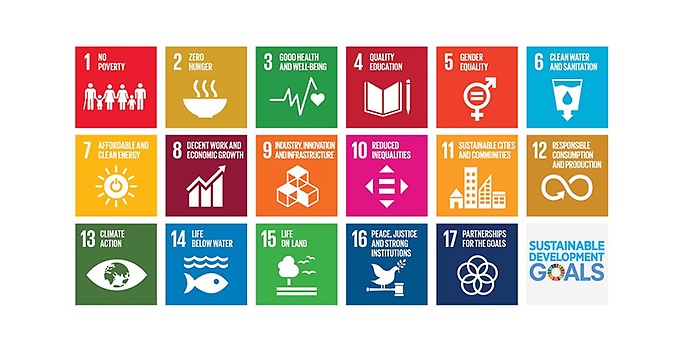1. December 2022 By Nehir Safak-Turhan
The many faces of sustainability – a general look at the UN Sustainable Development Goals
Sustainability has many faces and is not limited to environmental issues and the climate. I have described the consequences that this megatrend might have on the banking world in two previous blog posts. In this blog post, I would like to go beyond industry specifics and take a general look at the topic of sustainability based on the United Nations’ Sustainable Development Goals. It is important to understand these goals: with its Global Sustainability Agenda, the United Nations defines the elementary foundations and provides guidance for the sustainable development of society, politics and the economy.
What does the agenda cover? What are the specifics behind the goals and what might possible approaches to improve sustainability look like? I will take a detailed look at these questions in this blog post. After all, just like visiting the doctor, there is little sense is starting treatment for something (measures) without a clear diagnosis of what the problem is (understanding).
The United Nations Sustainable Development Goals – the Sustainable Development Agenda 2030
The Sustainable Development Goals (SDGs) of the United Nations were launched in 2016 with a timeframe of 15 years. They define a total of 17 Sustainable Development Goals with 169 targets to be achieved by 2030 within the framework of sustainable development.
What all the goals have in common is that they serve a clear, overarching goal of using a global plan to strive towards ensuring sustainable development on an economic, social and ecological level. The goal is a sustainable world community that increases global prosperity, reduces inequalities in living standards, provides more equal opportunities and ensures that natural resources are used sustainably.
With the SDGs, the global community of 193 states commits to translating the common vision into national development plans in order to enable people around the world to live a decent life and at the same time to permanently preserve the natural basis of life. A closer look at the 17 individual goals makes it clear why action needs to be taken.

Fig. 1: United Nations Sustainable Development Goals (UN 2016)
Goal 1: No poverty
In 2015, 736 million people worldwide were living in extreme poverty (USD 1.90 per day). However, poverty is more than the lack of income and resources. It also manifests itself in the form of hunger and malnutrition, limited access to education and other basic services, social discrimination and exclusion and a lack of participation in decision-making processes. Ending poverty in all its forms everywhere is a defined Sustainable Development Goal.
Goal 2: Zero hunger
In 2017, there were 821 million people were undernourished (compared to 784 million in 2015). The UN forecasts that there will be around two billion people suffering from malnutrition in 2050. Ending global hunger, achieving food security and improved nutrition, and promoting sustainable agriculture are clear goals of the agenda. A profound change in the global food and agricultural system is a basic requirement for achieving this.
Goal 3: Good health and well-being
The third Sustainable Development Goal is to ensure healthy lives and promoting well-being for all at all ages. The indicators for this include general life expectancy or the mortality rate of children and mothers. For children under five, this number was 5.4 million in 2017. According to the UN, providing health systems with more efficient financing, improving sanitation and hygiene, providing better access to doctors and reducing air pollution can help achieve significant progress in this area.
Goal 4: Quality education
750 million adults around the world, two-thirds of which are women, are illiterate. Over 265 million children, 22 per cent of which are primary school age, are currently not in school. This goal is about ensuring inclusive and equitable quality education and promoting lifelong learning opportunities for all.
Goal 5: Gender equality
Achieving gender equality to enable an autonomous life is a Sustainable Development Goal and is defined by the UN as a fundamental human right as well as a necessary basis for a peaceful and sustainable world. It implies the end of all forms of discrimination and violence against women and girls (according to the UN, 18 per cent of women and girls between ages 15 and 49 worldwide experience physical or sexual violence). Access to economic and natural resources should be guaranteed regardless of gender. It also aims to promote equal participation and opportunities for women in taking on leadership roles at all levels of decision-making in all areas of society.
Goal 6: Clean water and sanitation
The sixth Sustainable Development Goal of the 2030 agenda is the first international goal to address both access to clean drinking water and sanitation as well as water protection. It includes ensuring the long-term availability of water, using water efficiently and promoting the management of water as a resource.
Goal 7: Affordable and clean energy
Everyone should have access to affordable, reliable, sustainable, modern energy by 2030. This requires the share of renewable energies in the global energy mix to increase significantly and the rate at which energy efficiency increases to double.
Goal 8: Decent work and economic growth
According to the UN, about half of the world’s population lives on about USD 2 per day, with a global unemployment rate of 5.7 per cent. Promoting sustained, inclusive and sustainable economic growth, full and productive employment and decent work for all will be ensured by building up a sustainable economy to guarantee social prosperity in which all participate.
Goal 9: Industry, innovation and infrastructure
This Sustainable Development Goal serves to promote sustainable and resilient infrastructures. It requires that industries establish environmentally sound processes, use resources efficiently and in cycles and use or develop clean technologies themselves.
Goal 10: Reduced inequalities
The tenth goal is intended to help make participation in prosperity and the distribution of income more equitable. Inequalities will be reduced by defining measures that take into account the needs of disadvantaged and marginalised population groups. Inequalities and large disparities in access to health, education and other goods must be minimised.
Goal 11: Sustainable cities and communities
Two billion people around the world have no access to waste disposal. The agenda therefore also contains making cities and human settlements inclusive, safe, resilient and sustainable as a Sustainable Development Goal.
Goal 12: Responsible consumption and production
This Sustainable Development Goal focuses on sustainable consumption and production patterns. It aims to ensure the promotion of resource and energy efficiency, the provision of sustainable infrastructure and access to basic services. In addition, a better quality of life will be achieved by offering green and decent jobs.
Goal 13: Climate action
Taking urgent action to combat climate change and its negative impacts is another UN goal. This includes mitigating greenhouse gas emissions, educating people and raising their awareness of the issue and creating capacity to adapt to the impact of climate change.
Goal 14: Life below water
Seventeen per cent of waters within national jurisdictions are now protected according to the UN – more than twice as many as in 2010. The 14th Sustainable Development Goal is to conserve and sustainably use the oceans, seas and marine resources for sustainable development.
Goal 15: Life on land
Protect, restore and promote the sustainable use of terrestrial ecosystems, sustainably manage forests, combat desertification, halt and reverse soil degradation and halt biodiversity loss – the 15th Sustainable Development Goal aims to achieve the comprehensive protection, restoration and sustainable use of ecosystems at national and international levels.
Goal 16: Peace, justice and strong institutions
The foundations of the 16th Sustainable Development Goal are to promote peaceful and inclusive societies for sustainable development, provide access to justice for all and build effective, accountable and inclusive institutions at all levels. One indicator for this is the number of identified victims of exploitation: 70 per cent of those affected worldwide are women and girls, and most are victims of sexual exploitation.
Goal 17: Partnerships for the goals
This Sustainable Development Goal focuses on cooperation between states. A successful Sustainable Development Agenda requires partnerships between governments, the private sector and civil society. This goal is intended to create the common conditions needed for this.
Sustainability at national level
Translating global goals into national laws and guidelines forms the basis for successful implementation and places equal responsibility on politics, business, science, companies and civil society. The German government defines the path to a sustainable society as a ‘future contract of the world community for the 21st century’ and formulates concrete targets and measures for each of the 17 goals within the framework of the German Sustainability Strategy (Deutsche Nachhaltigkeitsstrategie, DNS), which ensure a review and measure progress.
Summary
Ending extreme poverty, fighting inequalities and injustices, stopping climate change, promoting biodiversity and much more – the Sustainable Development Goals are as wide ranging as their implementation is challenging. As heroic as it may sound, the need for action is not driven by purely altruistic motives. Protecting the ecological basis of life and eliminating global imbalances are in our own interest and form the prerequisite for long-term social stability, ecological rationality and economic prosperity. If we do not fulfil this prerequisite, the foundations for society as a whole to participate in economic prosperity, social progress and cultural development will not be secured in the long term. Sustainability elements will also increasingly come into focus in the economy and at company level. New business models with attractive growth and earnings potential as well as changing market and customer requirements will accelerate this trend. Tighter regulatory measures such as the EU taxonomy, as well as national regulations and legislation, are also exacerbating this catalyst.
I will of course keep a curious eye on how these issues are reflected in the banking world and keep you updated. Stay tuned!
You will find more exciting topics from the adesso world in our latest blog posts.

